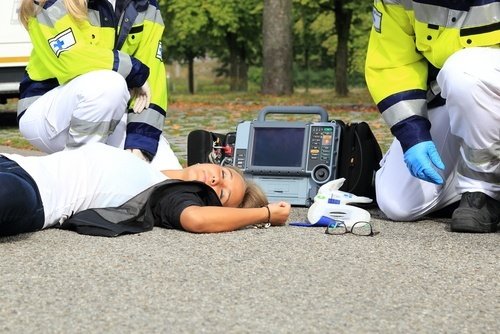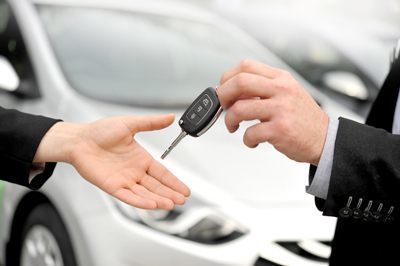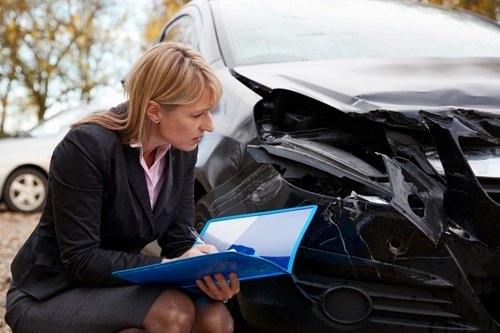Car Insurance Bodily Injury Protecion Versus Personal Injury Protection
Updated
California law requires drivers and vehicle owners to maintain bodily injury liability insurance in case they injure someone in an accident. Such insurance pays the other party's medical bills, lost wages, and other damages from physical injuries, up to the at-fault driver's policy limits.
Bodily injury liability insurance in California must be a minimum of so-called "15/30" insurance.1 This means that for any single accident the auto insurance will cover up to:
- $15,000 for the death or bodily injury of one person; or
- $30,000 total for the wrongful death or bodily liability of all people hurt or killed in the accident.
Policies with coverage limits greater than the 15/30 insurance requirement are sold by most California insurers.
Drivers and vehicle owners are personally liable for damages not covered by their liability insurance. Therefore, we strongly recommend that drivers purchase policies with higher limits than the state minimum limits if they can afford them.
To help you better understand bodily injury liability insurance, our California personal injury lawyers discuss the following, below:
- 1. What does California bodily injury liability insurance cover?
- 2. What is NOT covered by bodily injury insurance?
- 2.1. Damages in excess of policy limits
- 2.2. Car repairs bill and other property damage
- 2.3. Injuries to the policyholder or his/her passengers
- 3. Is liability insurance mandatory in California?
- 4. How much liability insurance do I need in California?
- 5. What is the process for defending a liability claim in California?
- 6. What if I was only partially at fault for an accident?
- 7. Why should I be represented by a California personal injury lawyer after a car accident?
You may also wish to review our article, 15 Steps to Take After a Car Accident in California.

California drivers are required to have motor vehicle insurance of at least the minimum amount allowed by state law.
1. What does California bodily injury liability insurance cover?
California bodily injury liability insurance pay's another person's medical bills when they are injured in an accident caused by the policyholder.
Losses included in bodily injury liability coverage can include (but are not limited to):
- Ambulance costs;
- Emergency room charges;
- Doctor's bills and other medical expenses;
- Hospital bills and other medical payments;
- Chiropractor bills;
- Physical or occupational therapy;
- X-rays and MRIs;
- Short- or long-term care (such as home health aides);
- Prosthetics;
- Dental expenses resulting from broken teeth; and
- Funeral expenses.
Bodily injury liability insurance also covers the injured person's past lost wages and future lost earning capacity if their injuries prevent them from working.
2. What is NOT covered by bodily injury insurance?
2.1. Damages in excess of policy limits
Bodily injury liability insurance will pay damages up to the limits of the policy. Drivers are personally liable for any amounts in excess of this limit.
Example: While checking a text on her phone, Jeanette accidentally runs a red light and hits a motorcycle driven by Hal. Hal suffers a fractured arm and a head injury.
Jeanette has the minimum 15/30/5 liability insurance required by California car insurance coverage law. But Hal's medical bills total $50,000. Jeanette is personally liable for the excess $35,000 in medical bills ($50,000 less the $15,000 her insurance covers).
2.2. Car repair bills and other property damage
Bodily injury liability insurance does not cover car repair bills or damages to other property, such as fences or gates. California drivers are required by law to carry property damage liability insurance ("collision coverage") in addition to bodily liability insurance to cover such losses.
Bodily injury liability insurance and property damage liability coverage are often collectively referred to by three numbers, such as 15/30/5. These numbers mean that a driver's liability coverage for any given accident is:
- $15,000 for bodily injuries to any one person;
- $30,000 collectively for bodily injury to more than one person; and
- $5,000 for property damage.
Example: In the example above, Jeanette's property damage policy could not be used to pay any of Hal's medical bills that exceeded her 15/30 liability limits. The $5,000 in property damage coverage would cover only the costs of repairing or replacing Hal's motorcycle.
Note that "comprehensive coverage" covers car damage resulting from things other than crashes, such as vandalism. Drivers are always advised to get additional coverage on their auto insurance policy.
2.3. Injuries to the policyholder or his/her passengers
Liability insurance is a form of third-party insurance that covers damages sustained by pedestrians or people in other vehicles that the policyholder hits. It applies when the policyholder is at fault for the accident.
It does not cover the policy holder's own injuries or property damage.
Several types of insurance may be available to pay for injuries sustained by a California driver and/or her or her passengers:
- The driver's personal health insurance;
- The other driver's bodily injury liability insurance (if the other driver was wholly or partially at fault);
- Optional California "Med Pay" insurance (which applies to the driver and his/her passengers regardless of fault); and
- Optional California uninsured motorist property damage coverage / uninsured motorist bodily injury coverage / underinsured motorist coverage (which pays if the other underinsured or uninsured driver is wholly or partially at fault).
Additionally, if the other driver was wholly or partially at fault, he/she may be personally liable for damages under California's "shared fault" law.
3. Is liability insurance mandatory in California?
Yes. California law requires drivers and vehicle owners to maintain bodily injury liability insurance with a minimum of 15/30/5 limits.
Such insurance also covers:
- Someone other than the policyholder who drives a covered vehicle with the policy holder's permission; and
- The policyholder while driving another vehicle (for instance, a rental vehicle).
Refer to your policy or check with your insurer to make sure you understand when and under what conditions your liability policy applies.

Auto coverage lenders tend to give good drivers lower insurance rates than drivers with past accidents on their driving record.
4. How much liability insurance do I need in California?
California drivers and vehicle owners should generally buy as much car insurance as they can afford. Insurance costs do not increase significantly as coverage levels go up.
Sometimes simply knowing that you can pay for injuries you inflict on another can bring you much peace of mind. Additionally, you will know that you will not lose your home or other property due to a lawsuit for damages.
People with few assets and low income may be alright with California's minimum liability insurance of 15/30/5.
But those with a home, stocks, jewelry, art, equipment or even a steady paycheck will often need more. Injuries from an accident can cost tens or even hundreds of thousands of dollars.
Recommended car insurance limits
CarInsurance.com recommends the following policy limits as a guide:
- 50/100/50: Best for those with few assets, who don't drive much and are on a tight budget — for instance college students and retirees.
- 100/300/100: Appropriate for most middle-income earners with a typical level of savings.
- 250/500/100: Best for those who own a home or have significant assets or savings.
You may also wish to purchase a California personal umbrella insurance policy to extend your protection by $1 million or more.
An umbrella policy is relatively inexpensive and provides extra insurance for all policies of insurance (not just auto liability) which the policyholder maintains at the maximum available limit.
5. What is the process for defending a liability claim in California?
California Vehicle Code 16000 requires drivers to report an accident on a California DMV Form SR1 within 10 days of an accident if:
- Anyone was killed or injured (even if the injury was minor), or
- There was property damage of more than $1,000.
Most policies of insurance also contain the obligation to notify them promptly if their policyholder is involved in an accident.
Once the insurance company receives notice, it will assign a claims adjuster
The claims adjuster will investigate the accident to determine who was at fault. During the investigation the adjuster may:
- Take your statement;
- Speak to the other driver (or more likely the other driver's insurance adjuster or lawyer);
- Review police reports (if any);
- Speak to witnesses;
- Inspect the damaged vehicles and accident scene or photos; and/or
- Review medical records of anyone claiming injuries.

Motorists must drive with both their driver's license and proof of insurance that meets minimum liability coverage requirements.
6. What if I was only partially at fault for an accident?
Under California's "shared fault" / "comparative negligence" law, blame for an accident can be apportioned to more than one party.
Having an experienced California injury lawyer can help ensure that you are assigned the least blame possible.
You may even be able to recover some of your own damages, such as your medical bills or lost wages or the cost of repairing your car.
7. Why should I be represented by a California personal injury lawyer after a car accident?
Insurance adjusters work for the automobile insurance company. In many cases, their interests will align with yours – at least initially. They, too, would prefer that another insurance company be liable for damages.
But they are not interested in getting you the largest settlement, especially if they are the ones paying — either because the accident was the other party's fault or because you are making a claim under your uninsured / underinsured motorist policy.
The adjuster's only job is to keep the insurance company's costs down. This can mean denying or delaying your claim in the hope that you will simply go away.
Often they will not even take the time to properly investigate the claim and learn what really happened. Or the adjuster will pressure you to accept less than your claim is worth.
Hiring your own lawyer is the best way to ensure that YOUR interests are protected.
An experienced California accident lawyer will independently investigate the accident and fight for your interests. If you need medical care, your lawyer will help you find it.
Your lawyer will also make sure that your settlement agreement is not just boilerplate that protects the insurance company's interests at the expense of your own.
And if you need to take your case to a California jury trial, your California car accident lawyer will make sure the jury hears your side of the story in the most sympathetic way possible.
Need a California accident lawyer? Call us for help…
If you or someone in your family has been in a car accident, we invite you to call our California auto accident attorneys for a free consultation to discuss your case.
Contact us to speak to an experienced lawyer about your car accident today.
We may also be able to help if you were in a car accident in Nevada or you need to know about Nevada's bodily injury liability insurance laws.
Legal references:
Car Insurance Bodily Injury Protecion Versus Personal Injury Protection
Source: https://www.shouselaw.com/ca/personal-injury/car-insurance/bodily-liability-insurance/
0 Response to "Car Insurance Bodily Injury Protecion Versus Personal Injury Protection"
Post a Comment